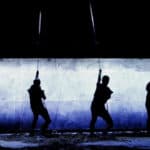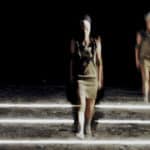Muta Imago. Displace (2011)
creation Muta Imago
direction, space, lights Claudia Sorace
drama, sound Riccardo Fazi
technical direction Maria Elena Fusacchia with the help of Luca Giovagnoli
voice off Speranza Franchi, Fabiana Gabanini
artistic and technical accompanying Luca Brinchi
training Glen Blackhall, Fabio Ghidoni
stage dresses Fiamma Benvignati
stage pictures Luigi Angelucci
stage technical assistance Giulia Maria Carlotta Pastore
organization Manuela Macaluso, Martina Merico, Maura Teofili
performance Anna Basti, Chiara Caimmi, Valia La Rocca, Cristina Rocchetti
soprano Ilaria Galgani
production Muta Imago 2011
coproduction Romaeuropa Festival 2011, Festival delle Colline Torinesi 2011, Focus on Art and Science in the Performing Arts
with the support of Regione Lazio – Assessorato alla cultura, Spettacolo e Sport
artistic residencies L’Arboreto – Teatro Dimora di Mondaino, La Corte Ospitale – Teatro Herberia, Inteatro Polverigi, Città di Ebla
in collaboration with Centrale Preneste, Kollatino Underground, Angelo Mai
premiere Rome, Romaeuropa Festival, Teatro Vascello, November 25, 2011
Displace. Presentation
by Riccardo Fazi
Displace is the last play in a two-year project which saw the creation of two independent performances: Displace#1 La Rabbia Rossa (Romaeuropa festival, October 2010) and Displace#2 Rovine (Festival delle Colline Torinesi, June 2011).
The structure can be divided into three panels. In the first, starting from Rovine, a wall or a piece of cloth on which plays of light reveal its appearance rises in the darkness of the stage and then collapses. Four human shapes move wildly, rummaging through the rubble with a flashlight. “The triumph of matter over video, but also the symbol of the fragility of man and the contemporary society he has created, and one cannot avoid thinking of the Old Testament” of ashes you were, ashes you will be.” The panel, La Rabbia Rossa, in which the four performers are “absent humanity walking nonchalantly”along the paths marked out by beams of light, “is the rage of Euripides’ Trojan Women for the destroyed city, but it is also the anger of our generation for this catastrophe which is unfolding and cannot be stopped.” Finally, the last panel in which the edges of the stage floor, on which the rubble has been scattered, rise and fold in on themselves to form an ambiguous image, like the prow of a ship, a journey of deliverance or a possible shipwreck.
Documents are published in original language. In case the translation is present, both the original and the translation are published.
Claudia Sorace, Piccolo manifesto del mio spazio in Studenti Architettura Siracusa, In Ombra, Vol. 3, LetteraVentidue Edizioni, Palermo 2013
Displace
Simone Pacini, Displace. Con Muta Imago profughi tra le rovine di noi stessi, «Krapp's Last Post», December 3, 2011
Simone Nebbia, Displace di Muta Imago: tra le macerie il motivo del mondo, «Teatroecritica», November 30, 2011
Matteo Vallorani, Displace di Muta Imago, «Altrevelocità», November, 2011
Graziano Graziani, Il teatro sradicato. Muta Imago presenta Displace, «Paese sera», November, 2011
Gianfranco Capitta, Un naufragio salvifico spezza le pesanti catene del sadismo, «il Manifesto», November 27, 2011
Michele Pascarella, Muta Imago: archeologia del presente, «Artribune», March 27, 2013
Interview with Claudia Sorace - Muta Imago «AbracadAmat», March 30, 2012







